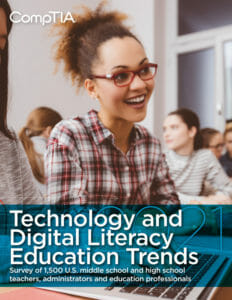Importance of Technology and Digital Literacy Education
Education professionals in a majority of U.S. middle schools and high schools are interested in expanding and improving technology and digital literacy education but acknowledge there are significant obstacles to overcome, according to a new report from CompTIA, the nonprofit association for the information technology (IT) industry and workforce.
Upgrading classroom technology and learning tools (cited by 65% of survey respondents), curriculum updates (58%) and developing post-graduation pathways for students (52%) are some of the steps that education professionals would like to take in response to growing student interest in digital literacy and technology.
To do so, however, will require expansion, improvements and upgrades of current tech and digital literacy programs, CompTIA’s survey of 1,511 middle and high school educators reveals. These changes include offering more “hands-on” learning elements, such as labs and simulations (61% of respondents); better support materials and training for teachers (52%); more relevant materials that resonate with students (52%); and resources that are more connected to employability skills (34%).
To assist schools in their efforts to improve digital literacy and technology classes and curriculum CompTIA announced an ambitious plan to connect with 5,000 schools over the next five years to have them begin or expand their use of the extensive tech learning and career resources available from the association.
“A strong foundation of digital literacy will help students succeed in the classroom throughout their schooling and readies them for the global digital economy regardless of the career journey they take,” said John McGlinchey, CompTIA executive vice president for global business development. “From fundamental digital skills to advanced areas such as cybersecurity, networking and technical support CompTIA has the learning tools and resources to help any school create or enhance its tech curriculum.”
Aided by significant input from the academic community, technology companies and other organizations, CompTIA has developed a comprehensive learning framework to prepare student for success in an IT career. CompTIA Connect 4 links skills development, professional certifications, work-based learning and industry sector partnerships as the critical components necessary to prepare students for the jobs they seek.
More than 5,100 educational institutions and other organizations have access to CompTIA tools and resources to help to support a technology curriculum through the CompTIA Academic Partner Program. The program also offers instructors opportunities for continuous training and teaching best-practices through CompTIA’s connected global network. Complete details are available at https://partners.comptia.org/become-a-partner/academic-partner.
Assessment of Current Digital Learning Programs
Just over two-thirds of schools (68%) say their current technology or digital literacy programs generally meet expectations. The data indicates a positive correlation between tech-savvy schools and commitment to technology education and digital literacy. For example, schools reporting they are ahead of the curve in technology utilization are more likely to require some form of technology education or digital literacy class vs. schools in the middle or behind the curve in technology utilization.
Slightly more than half of schools (56%) indicate technology or digital literacy classes are a requirement at some point between the 7th grade and 12th grade. These classes are available as an elective at 44% of schools. Larger schools with more than 1,000 students report offering technology or digital literacy classes at slightly higher rates than smaller schools. The same is true for school located in larger cities (250,000 or more residents) vs. towns with 50,000 or fewer residents. Classes are available at similar rates at both public and private schools.
Common class offerings include an introduction to computers and technology (61% of all schools surveyed), computer science (54%), introduction to digital skills and literacy (45%) and programming, coding and software development (41%).
Other areas of technology that are growing in importance and as career options, such as data analytics and cybersecurity, are currently much less common in the classroom, with both offered at about one in five schools. That may be changing, though. Close to eight in 10 educators identified those two disciplines as priorities for future foundational technology education, along with software and application development, hardware and networking, coding and general technology fundamentals.
CompTIA’s market evaluation of technology and digital literacy education is the result of a September 2021 survey of 1,511 U.S. teachers, administrators and other education professionals at middle and high schools across the country. The report is available at https://www.comptia.org/content/research/technology-and-digital-literacy-education-trends/.

About CompTIA
The Computing Technology Industry Association (CompTIA) is a leading voice and advocate for the $5 trillion global information technology ecosystem; and the estimated 75 million industry and tech professionals who design, implement, manage, and safeguard the technology that powers the world’s economy. Through education, training, certifications, advocacy, philanthropy, and market research, CompTIA is the hub for advancing the tech industry and its workforce. Visit https://www.comptia.org/.

